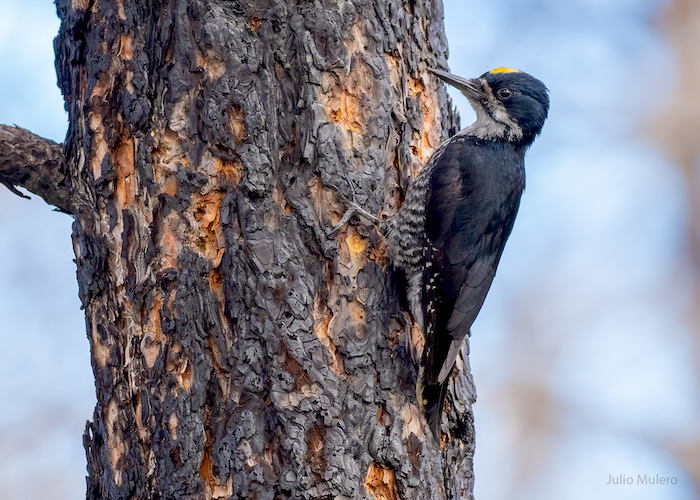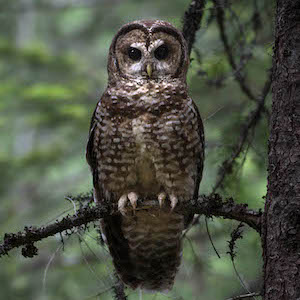The age-old human story of a youngster leaving home in search of greener pastures plays out in other species as well. The area where an animal was born or hatched may become too crowded or inhospitable in some other way, making it advantageous to disperse and find a better location to settle and breed. This is called “natal dispersal.” Many young Black-backed Woodpeckers leave home, although in their case they seek blacker pastures, not greener ones.
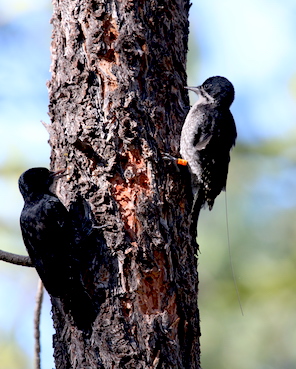
A fledgling Black-backed Woodpecker (right) fitted with a radio transmitter. The fine wire extending from the back of the bird is the transmitter's antenna. Photo courtesy of Andrew Stillman.
Black-backed Woodpeckers are post-fire specialists. For them, a “greener pasture” is a patch of recently burned forest with plenty of dead and blackened tree trunks. These grim-looking habitats are where they find their preferred food--the large, meaty larvae of woodboring beetles--which quickly colonize burned trees after a fire. But as the years pass, burned trees decay and beetle larvae become less abundant. A young Black-backed Woodpecker must assess its natal burn and decide: “Should I stay or should I go?”
In a paper published last week in the journal Behavioral Ecology, Andrew Stillman of the University of Connecticut, along with colleagues from The Institute for Bird Populations, the US Forest Service and the University of California examined natal dispersal strategies in young Black-backed Woodpeckers. The researchers used radio telemetry to track the dispersal of young Black-backed Woodpeckers that hatched in seven areas burned within the last 10 years in California and Washington state. They fitted young woodpeckers with radio transmitters just prior to fledging and then tracked the birds’ movements over the fall and the following spring to determine where they settled to breed.
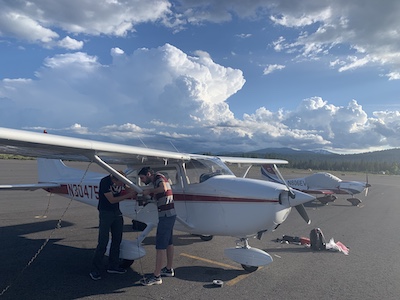
Andrew Stillman and a LightHawk pilot affix a radio receiver to the plane prior to flight. Photo courtesy of Andrew Stillman.
Finding a young woodpecker that has left its natal burn is difficult, even if it is tagged with a radio transmitter. The birds can travel long distances and radio signals from transmitters may not reach very far in mountainous terrain. Driving can help human trackers cover long distances but there are limits to where roads go. So Stillman and colleagues had to take the radio receivers to the skies with help from LightHawk Conservation Flying, a non-profit that connects volunteer pilots with conservation projects. LightHawk’s pilots donated expertise, time, aircraft, and fuel, providing Stillman and colleagues with flight support for no direct cost.
Flying in small aircraft at low altitudes over mountainous terrain is different from a typically smooth commercial jet flight at 30,000 feet. IBP biologist Bob Wilkerson, who is a co-author on the paper and who operated the radio receiver on many of these flights, was thankful for his LightHawk pilot’s skill and abundance of caution about turbulence. “He did not like flying in any kind of turbulence and that was a really good thing because I don’t particularly love to fly in small planes, and I get motion sickness really easily!”
After many miles of driving and many hours of flight time, Stillman and colleagues found that young woodpeckers that hatched in older burns were more likely to disperse -- and move longer distances -- compared to woodpeckers that hatched in younger burns. We talked to Andrew Stillman about the study:
Can you explain why a young Black-backed Woodpecker would want to move from the fire it was hatched in?
Searching for signals from radio tagged Black-backed Woodpeckers in the Bald Fire area. Photo courtesy of Andrew Stillman.
For a Black-backed Woodpecker, a recently burned forest is a great place to raise young. Dead trees provide lots of big, juicy beetle larvae and abundant places to build a nest. But as the years go by, dead trees fall and beetle larvae decline. If we zoom out to look at an entire landscape, burned areas are like little resource islands that blink on and off – appearing after fire and gradually fading as the forest regrows.
But when the best place to live is a moving target, you need a strategy to follow. If you’re a baby Black-backed Woodpecker in a recent burn, you’re surrounded by food and great places to settle and raise a family. But if you’re in an older burn, the pickings are slim. In those cases, it’s in your best interest to strike out in search of a new post-fire island of resources. If you’re one of the first ones to arrive after fire, you’ve hit the jackpot!
Why is this different than other birds who might use patchy habitats, for instance birds that breed in montane meadows?
The thing that sets this system apart from other patchy habitats is the fact that these patches are temporary, and they appear quickly and unpredictably on the landscape. It’s like whack-a-mole – you never know when or where the next great patch will pop up, but you want to find it when it does.
What about this study surprised you the most?
The thing that surprised me the most was just how far young black-backed woodpeckers are willing to go in search of recent burns. We tracked one bird as it dispersed over 50 km (31 miles) from its nest before settling in the area of a recent forest fire.
I was also surprised by the extent to which dispersal patterns change with years since fire. If you’re a Black-backed Woodpecker who hatched in a new burn, it’s quite likely that you’ll stick around. But if you hatched in an area 10 years after fire, there’s almost a 100% chance you’re going to move far away from home. It goes to show how much these burned habitats – and the food resources they provide to woodpeckers – change over time.
What are the conservation implications of this study?
One thing about Black-backed Woodpeckers has puzzled us for a long time: soon after a fire burns, the birds always seem to show up. Where do they come from? When populations decline in older post-fire forests, where do the birds go? This study gives us a window into the complicated ways that Black-backed Woodpeckers persist in a network of patchy habitat. Understanding the process that allows woodpeckers to colonize new habitat gives us clues for how to better manage recently burned areas to benefit woodpecker populations.
As wildfires change due to climate change and other factors, how do you think the phenomena reported in this paper will change or not change?
A clear next step for this research is studying how climate-induced changes to fire regimes will influence dispersal patterns. What will the colonization process look like in extra-large fires such as California’s Dixie Fire? To understand this process, we need to look further than the woodpeckers themselves – we need to also understand their food.
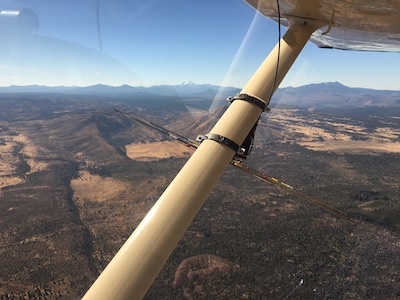
Searching for radio-tagged Black-backed Woodpeckers over Lassen National Forest. The radio receiver antenna is visible on the wing strut. Photo by Bob Wilkerson. Flight provided by LightHawk.
For the woodpeckers to thrive, woodboring beetles must be able to find and reproduce in dead trees. If the beetle colonization process is disrupted by the sheer extent of megafires, how will Black-backed Woodpeckers respond? Evidence from several large megafires suggests that there may be fewer black-backed woodpeckers than predicted in the giant fires that are becoming more common with climate change.
The Black-backed Woodpecker is a well-known post-fire specialist in the Sierra Nevada region and so its ecology is inextricably linked to wildfire. But many other bird species in the region are also affected by changing fire regimes. That’s why IBP partners with the US Forest Service and others to study the effect of wildfire- and forest management practices often used to mitigate the effects of wildfire- on bird species including not only Black-backed Woodpeckers, but also Northern Goshawks, Great Gray Owls, and more.


